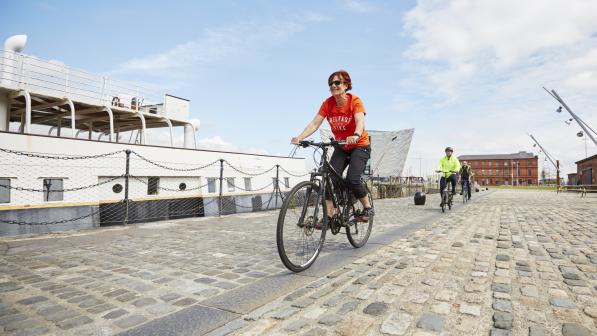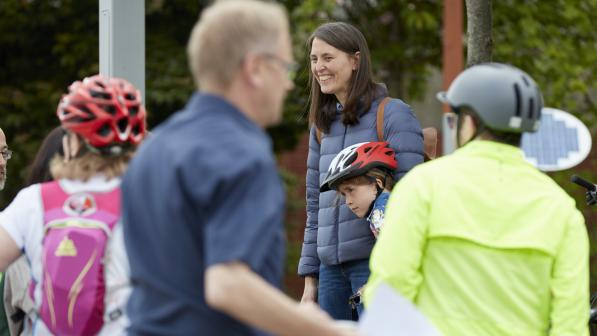Active Travel Act could get more people cycling in Northern Ireland

In the run-up to May’s Assembly elections, Cycling UK will be asking candidates to pledge to champion active travel, and we’ve published a manifesto setting out our key asks, which include introducing an Active Travel Act.
Please show your support by signing our petition.
But before we delve into how an Active Travel Act could benefit cycling, walking, and wheeling in Northern Ireland, it’s important to clarify some of the terms commonly used.
What is 'active travel'?
Active travel is walking and cycling for everyday journeys, for example to and from work, school, health, leisure or other service facilities, with walking including the use of wheelchairs, mobility scooters and other mobility aids.
It isn’t meant to describe purely recreational walking or cycling, though if you’re fortunate enough to be able to walk or cycle to work along a scenic route, you’re probably undertaking a journey with both active travel and recreational or leisure purposes. If the primary purpose is recreation, however fun and beneficial that may be, it isn’t an active travel journey.
What are active travel facilities?
These can include:
- Pedestrianised and pedestrian-priority areas - where cycling may or may not be allowed
- Traffic-free paths - where cycling may or may not be allowed
- On-road cycle routes
- Traffic-calmed streets
- 20 mph zones or limits
- Crossings, bridges, underpasses
- Cycle parking
- Signing
- Provision for integrating cycling with public transport journeys
What is an Active Travel Act?
An Active Travel Act (ATA) is essentially legislation which places a statutory requirement on various levels of government to take steps to enhance infrastructure for people walking and cycling, including when they carry out any transport infrastructure development or maintenance.
So, whenever a government or council make changes to our roads, transport legislation or public transport, an ATA could require them to consider and improve provision for active travel.
The precise requirements of an ATA can vary from country to country depending on needs, existing legislation, and which bodies have responsibility for transport.
How does the Active Travel Act work in Wales?
Wales is the first, and only country to have passed an ATA, and whilst Northern Ireland has a different structure for transport responsibility and infrastructure to Wales (more on this later), there’s still much we can take from the Act passed by the Senedd in 2013.
In Wales, the ATA applies mostly to local authorities (LAs), as the responsibility for creating, maintaining and improving highways lies mostly with them, but the Act does also apply to ministers.
The Act:
- requires LAs to map existing active travel routes, and to map proposals for future integrated routes
- requires LAs to deliver year on year improvements for active travel routes and facilities, for example cycle parking
- applies in built-up areas with populations greater than 2,000
- requires specific design and delivery guidance to be followed to ensure compliance with standards and integration with both the overall network plan and public transport.
How does Northern Ireland differ regarding transport and active travel?
In Northern Ireland, the responsibility for transport infrastructure is mostly centralised and sits with the Department for Infrastructure (DfI).
Local Authorities do still play a role, firstly in the consultation stage of local infrastructure development, and they also have responsibility for the delivery of the greenway network (Ards and North Down council were recently awarded over £3.2 million for greenway development from the Westminster ‘levelling up’ fund).
Due to the centralisation of responsibility, an ATA in Northern Ireland would have to hold the Minister for Infrastructure and the DfI itself accountable for enhancing and developing active travel provision and infrastructure. There could potentially be some parallels with the proposals in the current Climate Change Bill regarding setting targets, developing proposals and delivering infrastructure to meet those targets, and imposing a duty to report on those targets.
How would an ATA benefit Northern Ireland?
Beyond the obvious advantage that an ATA could require ministers and civil servants to improve provision for active travel, there are other major benefits given the power structure we have in Northern Ireland, because:
- The Act would apply to the Minister for Infrastructure regardless of their (or their parties’) position on active travel, and if they failed to consider active travel when delivering infrastructure development they could be held accountable, and be challenged legally.
- If Stormont collapsed, the ATA would continue to hold civil servants in the DfI accountable for considering and delivering active travel improvements year on year.
- It would give the public an opportunity to hold politicians to account.
What could be included in a Northern Ireland ATA?
A wide range of measures could be considered for and included in an ATA, and the following suggestions are by no means exhaustive:
- A minimum spending commitment on active travel directly related to the overall transport budget (we are calling for 10% – in line with the current commitment in Scotland).
- A requirement to accurately track numbers of people cycling, walking and wheeling in our cities and towns – to evaluate progress, we need to count the numbers.
- Targets for increasing the percentage of journeys walked and cycled.
- Active travel delivery guidance, which provides for the needs of people with disabilities.
- A requirement to create an accurate country-wide AT network map of existing and proposed future provision.
- Targets for Translink to increase numbers of those walking and cycling to access public transport, and an improvement of facilities enabling them to do so, for example secure cycle parking and increased space for bikes on trains.
- Targets for reducing motor traffic.
Political support for an ATA
This isn’t the first time an ATA has been proposed to candidates and parties before an election, and a campaign by Bikefast 2016 showed that 97% of candidates (74% response rate) supported the introduction of an ATA.
The Minister for Infrastructure, Nichola Mallon, also showed her support as recently as November 2020, saying she was "actively considering an active travel bill” having asked officials to set out "a range of options for policy changes, resources and legislation”.
But the current Assembly didn’t even try to legislate for an ATA, so to make this happen we need parties and candidates to make an ATA part of their manifesto commitments, and we need to hold the new Minister for Infrastructure to account soon after they take up the post.
Take action
Bringing in an Active Travel Act is one of our primary manifesto asks, and is central to Cycling UK’s election campaign.
Please help us by adding your name to our petition in support of those asks.
If you’d like to know more about our campaigning, you can also subscribe to our monthly cycle campaign newsletter to stay up to date, and check our Cycling UK in Northern Ireland homepage to see what we’ve been getting up to!







